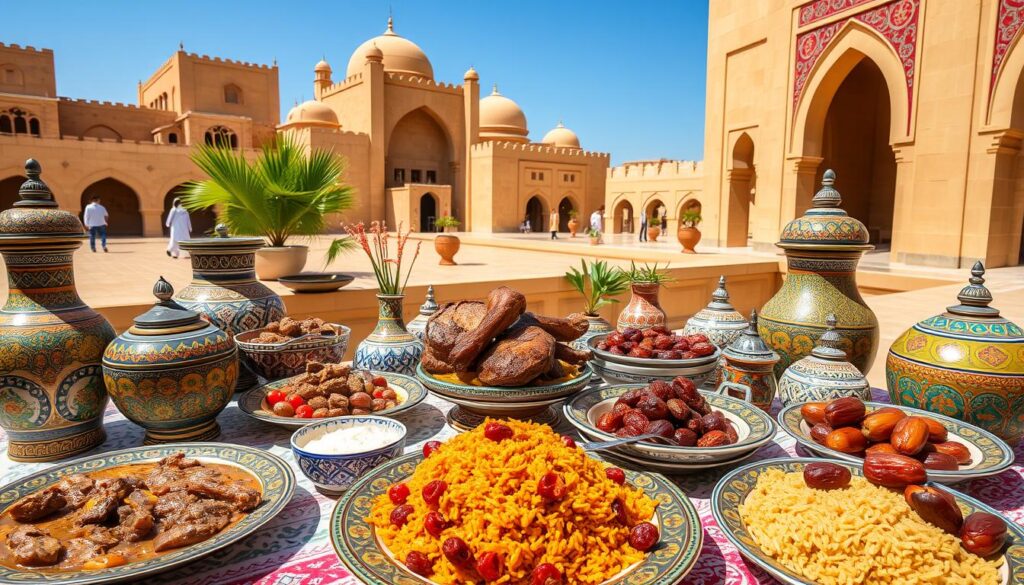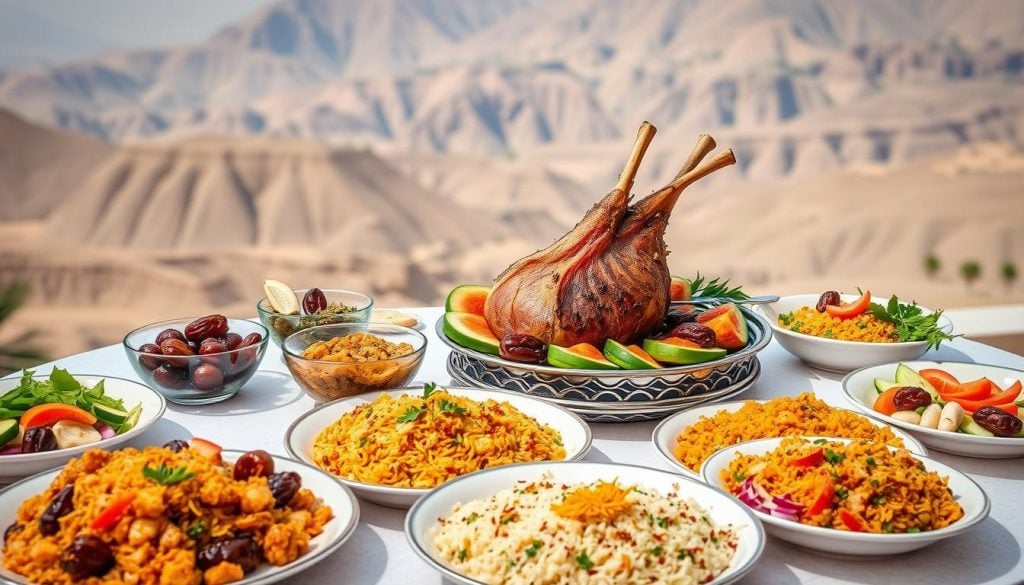Oman, a nation celebrated for its rich culture and heritage, carries a culinary tradition that spans centuries. At the heart of this tradition are the royal Omani recipes, dishes that have long graced the tables of sultans and nobles. These recipes are more than food they are stories, history, and artistry, blending flavors in a way that continues to inspire modern cooking across the globe.
A Glimpse into Royal Omani Cuisine
Royal Omani cuisine is an elegant mix of native Arabian flavors and influences from trading routes that connected Oman with Persia, India, and East Africa. Ingredients like saffron, rose water, dried limes, and exotic spices combine with seafood, lamb, and dates to create dishes that are fragrant, flavorful, and visually stunning. Traditionally prepared with patience and precision, these recipes reflect a philosophy that values balance, harmony, and an immersive sensory experience.
These dishes were designed not just to nourish but to impress. The presentation, aroma, and combination of textures were as significant as the taste itself. In royal kitchens, every meal was a celebration, a reflection of Oman’s opulence and its openness to global influences.
Influence on Contemporary Cooking Techniques
One of the most striking ways royal Omani recipes impact modern cuisine is through cooking techniques. Slow-cooking methods, marination, and careful layering of spices have influenced chefs worldwide. The precision in balancing sweet, savory, and sour flavors is now a hallmark of many contemporary dishes. Modern chefs often adapt these techniques, incorporating them into fusion recipes, upscale dining, and even home kitchens to achieve richer flavors and more complex taste profiles.
The art of slow-roasting lamb with saffron or infusing rice with rose water is now seen in international gastronomy. What was once exclusive to royal tables has evolved into a source of inspiration for culinary innovation. This influence bridges the gap between tradition and creativity, encouraging chefs to respect heritage while experimenting boldly.
Incorporating Omani Flavors into Global Cuisine
The unique flavor combinations of Omani cuisine are making their way into global menus. Spices like cardamom, turmeric, and cinnamon, often paired with dried fruits and nuts, are used in modern pastries, risottos, and gourmet dishes. Chefs are exploring the delicate balance of sweet and savory that Omani royal recipes excel in, creating dishes that surprise and delight the palate.
For instance, the use of dried limes, a staple in Omani cooking, adds an unexpected tang to stews and broths in Western kitchens. Similarly, saffron-infused desserts and beverages inspired by Omani traditions have found their way into luxury dining experiences worldwide. This cultural exchange enriches both traditional and modern cuisines, proving that flavors know no boundaries.

Presentation and Aesthetic Influence
Royal Omani recipes also teach the modern culinary world the importance of presentation. Every dish was an artwork, meticulously arranged to reflect elegance and refinement. This focus on aesthetics resonates with today’s food culture, where visual appeal is as critical as taste. Contemporary chefs are borrowing from these practices, using garnishes, layering, and plating techniques that echo the sophistication of Omani royal cuisine.
The modern foodie’s appreciation for Instagram-worthy meals and immersive dining experiences owes much to such traditions. By studying how Omani chefs present their dishes, contemporary kitchens are learning to turn food into an experience rather than just a meal.
Fusion Cuisine Inspired by Omani Royal Recipes
One of the most exciting outcomes of the influence of Omani royal recipes is fusion cuisine. Modern chefs experiment by blending traditional Omani elements with global culinary practices. A classic Omani dessert might meet French pastry techniques, or a spiced rice dish might be paired with Mediterranean seafood. These inventive creations pay homage to tradition while pushing culinary boundaries.
Fusion inspired by Omani cuisine often emphasizes harmony. The careful balance of spices, textures, and aromas guides chefs in creating dishes that are both authentic and innovative. This approach has led to a renaissance in contemporary cooking, encouraging global kitchens to respect cultural roots while embracing creativity.
Health and Nutrition Trends
Royal Omani recipes are not just indulgent they are balanced and nourishing. Ingredients like dates, nuts, fresh herbs, and lean meats contribute to meals that are wholesome and healthful. Modern cooking trends, especially those emphasizing clean eating and natural ingredients, find inspiration here.
Chefs are revisiting these recipes to create dishes that are lighter yet flavorful, reducing heavy fats while maintaining rich tastes. Traditional Omani techniques such as steaming, slow roasting, and using aromatic spices align perfectly with contemporary dietary preferences. This synergy between heritage and health makes Omani royal cuisine relevant in today’s wellness-focused culinary scene.
Reviving Forgotten Techniques
Many of the methods used in royal Omani kitchens are being revived by modern chefs. Techniques like clay pot cooking, smoking with natural herbs, and hand-ground spice mixes offer flavors that modern technology sometimes cannot replicate. Culinary schools and gourmet restaurants are incorporating these techniques into their curriculum and menu design, ensuring that the artistry of royal Omani cuisine is preserved and celebrated.
The revival of these techniques also connects diners to a sense of history. Each bite carries centuries of culinary knowledge, reminding us that food is a living tradition, constantly evolving while honoring its roots.
Cultural Exchange and Culinary Tourism
The global fascination with Omani cuisine has also fueled culinary tourism. Travelers seek authentic experiences, attending cooking classes, visiting spice markets, and enjoying royal-inspired meals. This exchange spreads Omani flavors and methods worldwide, influencing chefs, home cooks, and food enthusiasts alike.
Culinary tourism ensures that royal Omani recipes continue to inspire innovation. As more people experience these dishes firsthand, modern chefs incorporate these flavors into their menus, blending tradition with contemporary tastes to create meals that are both familiar and exotic.

Inspiring Home Cooking Trends
The influence of Omani royal recipes extends beyond professional kitchens. Home cooks are exploring these flavors through simple adaptations, learning to use spices, herbs, and cooking techniques in everyday meals. Recipes once considered elaborate are now approachable, inspiring a generation of food enthusiasts to experiment and innovate in their kitchens.
Home cooks are also inspired by the communal aspect of Omani dining. Sharing meals, emphasizing hospitality, and presenting dishes beautifully are values that modern cooking trends have embraced. These lessons remind us that food is more than sustenance it is a means of connection, expression, and celebration.
The Future of Omani Culinary Influence
The legacy of royal Omani recipes is far from static. As modern cooking evolves, these traditions continue to provide a foundation for innovation. From fine dining restaurants to home kitchens, chefs are finding ways to reinterpret ancient recipes for contemporary palates.
The trend is moving toward fusion, experimentation, and respect for authentic flavors. Ingredients like saffron, cardamom, and dried limes are being celebrated in new ways, while techniques from royal kitchens are adapted to modern cooking appliances and timelines. The marriage of tradition and innovation ensures that Omani cuisine will continue to influence global culinary trends for decades to come.
Conclusion
Royal Omani recipes are a treasure trove of inspiration for modern cooking. They teach us the art of balance, the value of patience, and the beauty of presentation. As chefs, food enthusiasts, and home cooks explore these dishes, the flavors, techniques, and aesthetics of Omani cuisine continue to shape contemporary culinary trends. From international gourmet kitchens to local dining tables, the legacy of Oman’s royal recipes remains a vibrant and evolving influence, reminding us that the past can nourish, inspire, and transform the future of food.
Also Read – Savoring Omani Seafood: Coastal Delights That Inspire Joy



